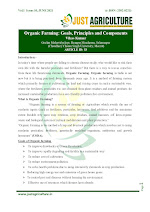Agroforestry Systems, Subsystems, Practices & Their Classification
Agroforestry systems across the world vary in structure and function. Their classification is essential for evaluation and strategic improvement. This blog explores key agroforestry terminologies, classifications, systems, and practical examples in detail.
Understanding Key Terms
Subsystem
- Indicates a lower hierarchy of the system.
- It is a component of the system with limited role and complexity.
- Subsystems meet defined outputs like food, energy, or cash.
Classification Criteria of Agroforestry Systems
Combe (1982) proposed a classification based on:
- Tree associations (with crops/pastures/both)
- Function (productive/protective)
- Spatial arrangement (regular/irregular)
- Temporal arrangement (temporary/permanent)
Major Bases of Classification:
- Structural Basis
- Functional Basis
- Socioeconomic Basis
- Ecological Basis
Nair’s (1985) Structural Classification of Agroforestry Systems
A. Nature of Components:
- Agrisilviculture / Silviagriculture
- SilvopastoralAgrosilvopastoral
- Other Systems
The primary component is always placed first in naming (e.g., Agrisilviculture = Agri crops + Trees)
B. Arrangement of Components:
Includes spatial arrangement, vertical layering, and temporal arrangement.
Agrisilviculture / Silviagriculture / Agrosilviculture Systems
These systems integrate agricultural and tree crops. Based on component nature, they include:
a) Improved Fallow in Shifting Cultivation
- Practiced in NE India, Jharkhand, Orissa, etc.
- Known as jhuming, kurwa, dahiya, etc.
- Old fallow cycles (20–30 years) reduced to 2–3 years.
- Leads to land degradation and ecological issues.
Effects:
- Deforestation, erosion, nutrient loss
- Decline in organic matter & microbial activity
Control Measures:
- Promote permanent agriculture
- Public awareness and training
- Animal husbandry & handicrafts promotion
- Legal & infrastructural support
b) Taungya System of Cultivation
- Origin: Burma (1850), India (1896)
- Mix of forestry + agriculture on same land
- Effective for forest regeneration and local livelihoods
Types of Taungya:
- Departmental
- Leased
- Village-based (Most successful)
Advantages:
- Cost-effective forest plantation
- Employment and food crop generation
- Weed and pest control
Disadvantages:
- Soil exposure, erosion
- Labour exploitation risks
- Legal and epidemic concerns
c) Alley Cropping (Hedgerow Intercropping)
- Leguminous trees/shrubs + arable crops in rows
- Pruned trees add mulch, improve soil and suppress weeds
Key Features of Trees:
- Nitrogen-fixing
- Deep tap roots
- Fast regrowth
- Fast-decomposing leaf litter
Prominent Species:
Advantages:
- Enhanced crop yield and soil fertility
- Reduced chemical fertilizer use
- Erosion control and added tree products
d) Crop Combinations with Plantation Crops
- Perennial crops (Tea, Coffee, Cocoa, etc.) + Intercropping
Examples:
- Tea under Albizia, Grevillea, etc.
- Coffee under Ficus, Erythrina, etc.
- Cacao under coconut or forest trees
- Black Pepper with support species
e) Agroforestry for Fuelwood Production
- Integration of fuelwood species around/within cropland
- Dual role: Energy + Protection (shelter, fencing)
Common Species:
Acacia nilotica, Eucalyptus spp., Casuarina, Prosopis juliflora
Shelterbelts
Shelterbelts are rows of trees or shrubs planted in a linear pattern, usually across the direction of prevailing winds, to protect agricultural land, crops, animals, and human settlements from strong winds, dust storms, and erosion.
Key Features:
- Planted in multiple rows (typically 3 to 5 or more), unlike windbreaks which may consist of only 1–2 rows.
- Arranged perpendicular to the wind direction to create a large protected zone (leeward side).
- Species used are usually fast-growing, drought-resistant, and wind-tolerant (e.g., Casuarina, Eucalyptus, Acacia, etc.).
- Often include a mix of tall trees, medium trees, and shrubs for maximum efficiency.
Structure:
- Tall trees in center, then shorter trees, shrubs, grasses on sides.
Characteristics of Ideal Species:
- Wind-firm, drought-resistant, fast-growing, dense crown
Recommended Species:
Acacia spp., Albizzia lebbek, Prosopis, Tamarix, Eucalyptus, etc.
Benefits:
- Reduced evapotranspiration & wind erosion
- Improved soil moisture & humidity
- Higher crop, fruit, and fodder yields
- Protection against sand movement and infrastructure damage
Windbreaks
Windbreaks are rows of trees or shrubs (usually 2–3 rows) that are strategically planted around agricultural fields, gardens, or farms to reduce the speed and impact of strong winds. Their main function is to protect crops, soil, and infrastructure from wind damage, desiccation, and erosion.
Hortisilviculture
Hortisilvopastoral
Hortisilvopastoral is an integrated agroforestry system that combines:
- Horticultural trees (fruit crops),
- Silvicultural trees (timber/fuelwood species), and
- Pasture/grassland components (grasses or legumes for livestock grazing or fodder).
This system is designed to maximize land productivity by producing fruits, timber, and livestock fodder simultaneously from a single unit of land.
Thank You
Vikas Kashyap










0 Comments